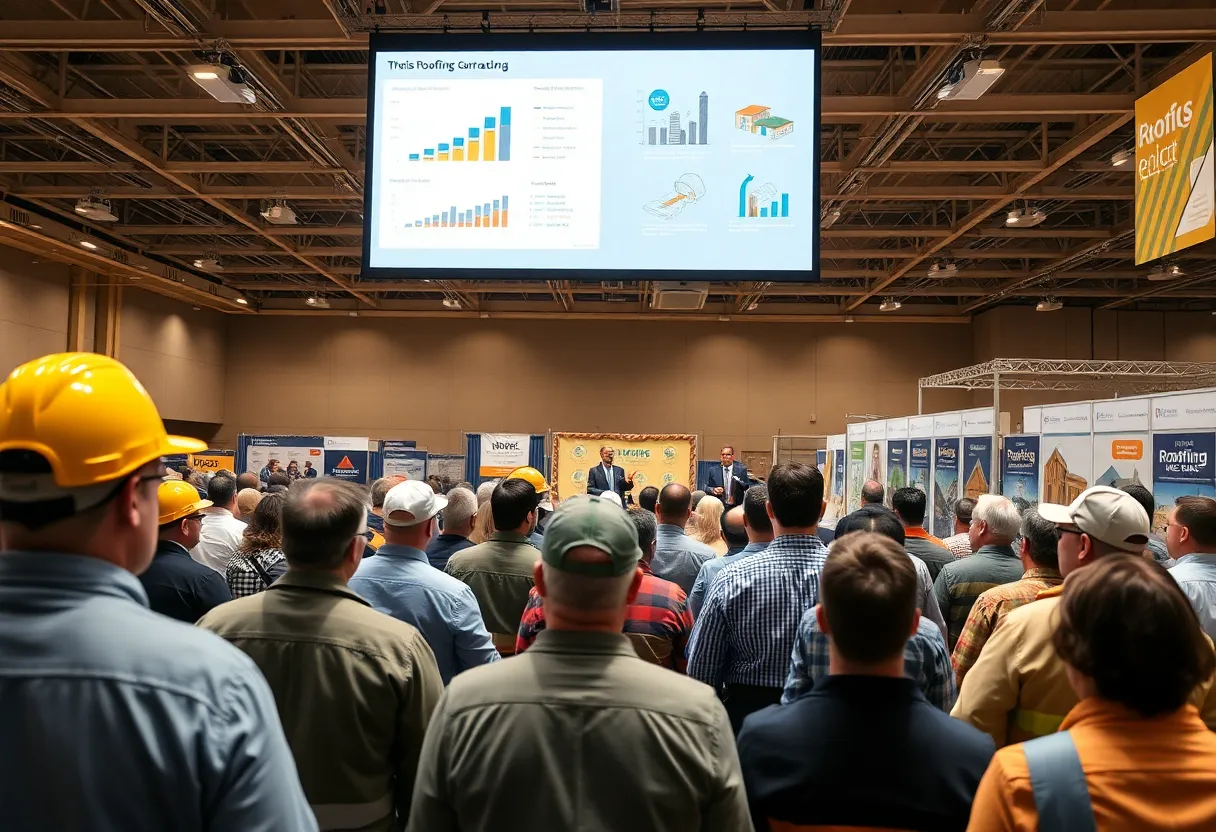Major industry expo, September 14, 2025
News Summary
A keynote at a major industry expo outlined five forces shaping the roofing market: regional bank stabilization, rising construction wages, strong private‑equity demand, political uncertainty, and tariff‑driven supply pressures. Stabilizing regional banks could ease construction lending constraints, while tighter immigration and sustained demand are driving wage pressure and localized labor shortages. Private equity remains active, favoring consolidation and tech investment. Tariffs on metals have increased costs and lead times, prompting contractors to use escalation clauses. Contractors are advised to stress‑test bids, invest in training and technology, maintain clean records for potential deals, and monitor supply channels.
Economic briefing at industry expo signals easing bank strain, rising wages and continued dealmaking that will reshape roofing work in 2025
A financial outlook delivered at a major industry expo lays out near-term forces roofing contractors should expect: regional bank stability that could reopen project financing, persistent wage pressure from constrained labor supply, sustained private‑equity interest in roofing assets, and political and trade uncertainty that continues to squeeze margins and slow some projects. These dynamics arrive alongside major moves by manufacturers and consolidators that will change distribution, sourcing and competitive patterns across the sector.
Banking and construction lending
Regional banks, which serve as the main lenders for many smaller commercial and multifamily projects, have stopped deteriorating and are showing signs of stabilization. Improved bank profitability driven by a deeper yield curve and the settling of last decade’s regional bank turmoil could loosen the freeze on construction lending that constricted projects in 2023 and 2024. Gradual improvement and a wave of potential mergers are likely to increase access to project financing over the course of 2025, but recovery will be uneven and project sponsors will remain cautious.
Labor, wages and immigration
Construction employment remains near cycle highs even while overall activity has dipped. Changes in immigration policy are cutting off a key source of workforce growth, tightening the available labor pool. With demand holding up for many segments—especially repairs, renovations and multifamily—contractors should prepare for continued wage inflation and workforce shortages. Skilled tradespeople will command premium pay, increasing project costs and potentially stretching schedules where hiring and retention are difficult.
Private capital, housing trends and demand shifts
Private equity firms hold substantial dry powder and continue to deploy capital into housing-related assets. Institutional and foreign buying keeps home prices elevated in many markets, shifting the rent‑versus‑buy balance toward renting. That dynamic boosts demand for renovation and multifamily roofing work while new single‑family construction faces affordability headwinds. The combination of institutional interest and constrained new‑build volumes bodes well for contractors focused on repairs, replacements and apartment work.
Political uncertainty and project pauses
Policy uncertainty has been a key factor in a recent summer slowdown in construction. Developers and property owners are reluctant to commit to large expenditures without clearer direction on tax, trade and infrastructure policy. As clarity returns, some delayed projects may resume, but contractor planning should account for stop‑start rhythms tied to shifting regulatory and fiscal signals.
Tariffs, materials and distribution consolidation
New tariff measures on key metals have roiled supply chains and pushed domestic premiums sharply higher, with some material premiums jumping more than 50 percent in weeks after levy announcements. Lead times have lengthened by roughly six to eight weeks, and overall material costs have climbed substantially since 2020. Contractors have increasingly used price‑escalation clauses to protect margins. Major distribution consolidation continues, including large strategic acquisitions that concentrate national distribution networks and reshuffle contractor access to product lines.
Manufacturing expansion and market entry
Large roofing manufacturers are investing in U.S. capacity with plans to scale nonresidential output and explore entry into asphalt shingle production. These moves aim to leverage existing commercial networks and cross‑sell insulation and waterproofing products, but they face high barriers: established supplier relationships, distributor consolidation and regulatory hurdles on emissions and permitting. If successful, new lines could shift supply balances and influence pricing and availability over the coming years.
Consolidation, private equity and platform dynamics
Deal activity remains brisk: private equity platforms are acquiring roofing businesses at a rapid clip, fueling investment in software, training and back‑office consolidation. Deal counts and platform rollups have surged, increasing the number of PE‑backed roofing companies. Buyers are more selective, emphasizing clean, traceable data, leadership continuity and the ability to withstand input‑cost shocks. Some acquirers have paused bolt‑on deals to focus on integration and governance.
Technology and operational resilience
Technology adoption is accelerating as firms chase efficiency: estimating and enterprise software, aerial measurement tools, and pilot projects in AI, predictive analytics and 3D modeling are becoming more common. These tools can reduce waste, speed estimating and improve workforce deployment, helping firms manage tighter labor markets and higher material costs. Post‑disaster reconstruction, insurer partnerships and public contracts offer stable revenue avenues for companies that can meet certification and service standards.
Implications for contractors
Roofing firms should stress‑test bids and platforms against higher labor and material costs, tighten contract language around escalation and pass‑throughs, and invest in training and retention incentives. Clean operational data will improve valuation in any sale process and strengthen responses to lenders and buyers. Where possible, diversify revenue between retrofit, multifamily and storm recovery work to reduce exposure to single segments. Expect consolidation and competition from larger platforms and new manufacturing entrants to continue through 2026.
FAQ
What does regional bank stabilization mean for contractors?
Stabilization suggests lending standards have stopped deteriorating and could slowly improve. Contractors may see easier access to construction loans and project financing during 2025, though the recovery will be gradual and uneven.
Will wages keep rising in 2025?
Yes. Reduced immigration and persistent demand for skilled trades are likely to sustain wage pressure, making labor one of the largest single cost risks on projects.
How does private equity activity affect small and mid‑size roofers?
Increased private equity interest brings capital, software investment and growth opportunities, but also more rigorous due diligence, consolidation, and pressure to standardize operations and reporting.
Should contractors be worried about tariffs and material shortages?
Tariffs have driven sharp price moves and longer lead times for metals and other inputs. Contractors should include escalation clauses, plan inventories, and cultivate multiple suppliers.
What technologies offer the biggest near‑term payoff?
Estimating and enterprise systems, aerial measurement tools, and unified HR/payroll platforms provide measurable gains in speed and accuracy. Early pilots of predictive analytics and AI may offer advantages for workflow planning and claims handling.
Key features at a glance
| Topic | What it means for contractors | Near‑term action |
|---|---|---|
| Regional bank stabilization | Potential easing of construction lending constraints | Prepare clean financials and pipeline data for lenders |
| Labor and wages | Skilled labor tight; higher labor costs | Invest in retention, training and signing bonuses |
| Private equity activity | More rollups, software investment, integration demands | Standardize reporting and data to improve valuation |
| Tariffs & materials | Higher prices, longer lead times | Add escalation clauses; diversify suppliers |
| Manufacturing expansion | New production capacity may shift supply balance | Monitor distributor relationships and availability |
| Technology adoption | Efficiency gains from software and aerial tools | Pilot estimating and drone measurement; scale successful tools |
Deeper Dive: News & Info About This Topic
Additional Resources
- Business Wire: Springer-Peterson Roofing Joins Roofing Corp of America
- Wikipedia: Springer-Peterson Roofing
- ABNewswire / FinancialContent: All American Roofs Expands Professional Roofing Services Across Florida
- Google Search: All American Roofs expands services Florida
- Financial Times: Market/Industry analysis (FT)
- Google Scholar: roofing market consolidation 2025
- Roofing Contractor: Tariffs, Talent and Tech — The New Rules of Roofing Consolidation
- Encyclopedia Britannica: roofing tariffs & construction industry
- Roofing Contractor: Kingspan flirts with disrupting the U.S. shingle market
- Google News: Kingspan shingle entry US





